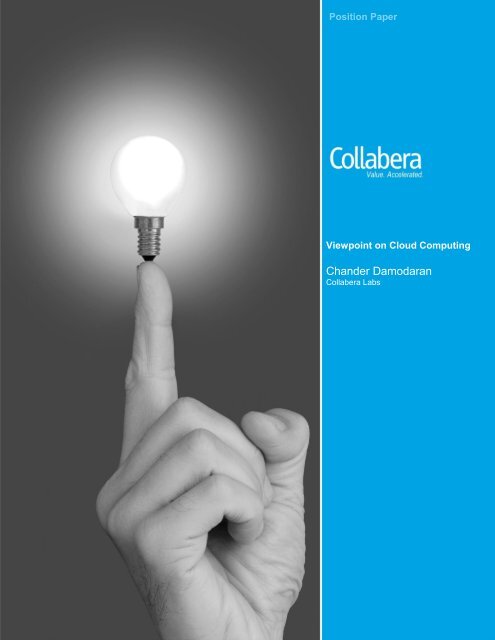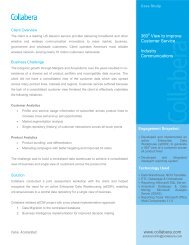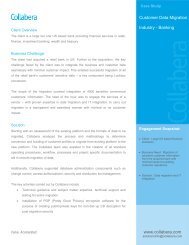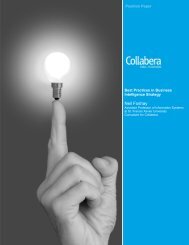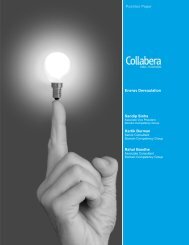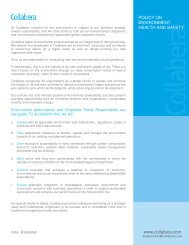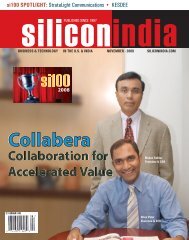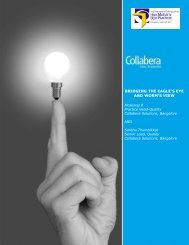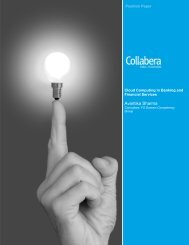Viewpoint On Cloud Computing - Collabera
Viewpoint On Cloud Computing - Collabera
Viewpoint On Cloud Computing - Collabera
You also want an ePaper? Increase the reach of your titles
YUMPU automatically turns print PDFs into web optimized ePapers that Google loves.
Position Paper<br />
<strong>Viewpoint</strong> on <strong>Cloud</strong> <strong>Computing</strong><br />
Chander Damodaran<br />
<strong>Collabera</strong> Labs
Overview<br />
<strong>Cloud</strong> computing - is this just a hyped up terminology or is this really the next big wave in IT<br />
towards a service based business model. What is cloud computing? What are the benefits, risks<br />
and challenges of cloud computing? Who are some of the key players in the cloud computing<br />
space? - These are some of the questions that architects and enterprises in general have today.<br />
This document tries to address some of these key areas.<br />
<strong>Cloud</strong> <strong>Computing</strong>: Background<br />
<strong>Cloud</strong> <strong>Computing</strong>, <strong>Cloud</strong> Services, Grid <strong>Computing</strong>, Utility <strong>Computing</strong>, *aaS – Everything as a<br />
Service, these are few of the terminologies used interchangeably to define cloud computing.<br />
<strong>Cloud</strong> computing is definitely a new terminology; however the underlying concepts like Grid<br />
computing, virtualization, timesharing that enabled cloud computing has been around for a long<br />
time.<br />
What is <strong>Cloud</strong> <strong>Computing</strong>?<br />
Wikipedia states – “<strong>Cloud</strong> computing is a broad term that refers to dynamic provisioning of<br />
common business applications and/or scalable and virtualized resources as a service over the<br />
internet.” This includes,<br />
• Infrastructure/Hardware as a Service (IaaS/HaaS)<br />
Value. Accelerated.
• Platform/Framework as a Service (PaaS)<br />
• Application/Software as a Service (SaaS)<br />
Brief introduction to Service layers<br />
Though cloud computing is a generic term, a clear demarcation of the type of service used, helps<br />
better deployment control to flexible/cost effective solution offerings.<br />
• Infrastructure as a Service: In traditional hosting services each customer is provided<br />
Value. Accelerated.<br />
with dedicated hardware. However, infrastructure cloud providers have a huge pool of<br />
shared resources that is dynamically provisioned to accommodate fluctuating demand<br />
from different enterprises. As a result, enterprises have far greater elasticity, economies<br />
of scale and cost advantage compared to traditional data centres. Following are the<br />
classification for infrastructure offerings,<br />
o Private <strong>Cloud</strong>: flexible computing resources built and provisioned internally for<br />
each enterprise users individually. Though this is still new and catching up with<br />
enterprises, there are good number of providers like Appistry, VMWare that<br />
enables building private clouds<br />
o Public <strong>Cloud</strong>: dynamic and metered provisioning of computing resources on the<br />
internet with a service dashboard to add/modify/remove resources or view<br />
resource usage and performance
Value. Accelerated.<br />
o Hybrid <strong>Cloud</strong>: enterprises that use a combination of the above two clouds<br />
generally fall in the classification of hybrid clouds.<br />
Key characteristics that qualify as IaaS offerings includes,<br />
o Automated Provisioning<br />
o Self-service portal<br />
o Ability to monitor resources and application performance<br />
Key vendors in this space include Microsoft, Amazon, VMWare, GoGrid, Flexiscale and<br />
Terremark among others<br />
• Platform as a Service: This is the next level of abstraction where vendors typically<br />
abstract the infrastructure and provide frameworks, runtime libraries, tools and IDE to<br />
develop/test cloud apps locally and deploy/host these apps in the cloud. Key<br />
characteristics that qualify as PaaS offerings includes,<br />
o Flexible services platform that provides a framework and a consistent<br />
programming model to develop<br />
o Internet standards based and interoperable with existing on premise apps/other<br />
cloud services<br />
o Allows natural extension of existing investments<br />
Key vendors in this space include Microsoft Azure, Amazon, Google App Engine and<br />
Force among others.<br />
• Software as a Service: Also termed Application as a service, includes ready to use<br />
applications across CRM, HRM, Financial Management domains and productivity tools<br />
like Office and Collaboration (email, messaging, blogs, wikis). Generally licensed on a<br />
per-user basis. Key characteristics that qualify as SaaS offerings includes,<br />
o Anywhere access and management of software on a pay per user basis<br />
o Supports single instance multi-tenant architecture for horizontal scalability<br />
o Can integrate/work with existing software investments<br />
Key vendors in this space include Microsoft, Zoho, Google Apps, Salesforce CRM, IBM<br />
LotusLive among others.
Traditional vs. <strong>Cloud</strong> based approach: A typical business case scenario<br />
Prior to cloud computing, business analysts/architects would capture functional/non-functional<br />
requirements and accordingly come up with application and deployment architecture that would<br />
support these requirements. Over the years, architects have been able to abstract and extract<br />
patterns for these commonly needed requirements.<br />
Let’s imagine an application that accepts user queries related to income computation and<br />
facilitates online filing of Tax returns. For completeness sake, if we were to take functional/non-<br />
functional scenarios, we wouldn’t see a major variation in design/architecture of the functional<br />
pieces between traditional and the cloud based approach, however it’s the non-functional<br />
requirements where one sees the most variation.<br />
Let’s take couple of NFRs and do a quick comparison of the solution options,<br />
advantage/disadvantage for each of these requirements between the traditional and the cloud<br />
based approach:<br />
Benefits, Risks & Challenges<br />
Business Benefits<br />
• Zero capital expenditure, minimal operational expenditure<br />
• Just in-time infrastructure availability<br />
• Dynamic scaling of resources leading to efficient resource utilization<br />
• Pay as you go utility style billing<br />
Value. Accelerated.
Risks & Challenges<br />
• Data security: top most concern in a public cloud, do cloud providers offer end to end<br />
Value. Accelerated.<br />
encryption, security and privacy protection<br />
• Data Control, Compliance & Integration: Key governmental regulations require certain<br />
data to be present within geographic boundaries and data within a single enterprise could<br />
be located in different data sources posing integration issues<br />
• Data Recovery: Ability to recover customer data in case of a disaster/emergency at the<br />
cloud data centres<br />
• Service Quality: Enterprises expect certain service levels and almost all cloud providers<br />
do not support all the SLAs currently<br />
Key Vendors Comparison<br />
As with any new trend, vendors both big and small are lining up with cloud-based/cloud-aware<br />
service offerings, the below chart tries to compare key vendors across each of the different cloud<br />
layers against key attributes. The players in this field and the vendor maturity are changing so<br />
rapidly that the following information is not an exhaustive list of all vendors and is current as of<br />
August, 2009.<br />
The comparison matrices are based on the following legend,
• IaaS – key vendor comparison matrix<br />
• PaaS – key vendor comparison matrix<br />
Value. Accelerated.
• SaaS – key vendor comparison matrix<br />
Cost Comparison<br />
Finally, an approximate cost comparison matrix of hosting a similar application across the key<br />
cloud vendors,<br />
Value. Accelerated.
Conclusion<br />
Every passing day, new vendors arrive at the scene with cloud service offerings. Eucalyptus has<br />
started maturing as an open standard in cloud computing. Jericho forum, part of Open Group<br />
managed consortia has laid out the design commandments and COA framework for building<br />
secure open cloud computing models.<br />
In the current market scenario, which is based primarily on cost economics coupled with demands<br />
for scalable, flexible and efficient systems that can support varied workloads, cloud computing is a<br />
prime candidate that slots well and can achieve all these and more, however given the inherent<br />
risks and challenges, enterprises have currently started experimenting with the cloud. Some of the<br />
major cloud vendors like Microsoft offer a consistent and a programmable interface to mix and<br />
match on-premise applications with cloud based/cloud aware offerings, accelerating the pace of<br />
cloud adoption by enterprises.<br />
Value. Accelerated.
www.collabera.com<br />
solutionsinfo@collabera.com<br />
Value. Accelerated.


